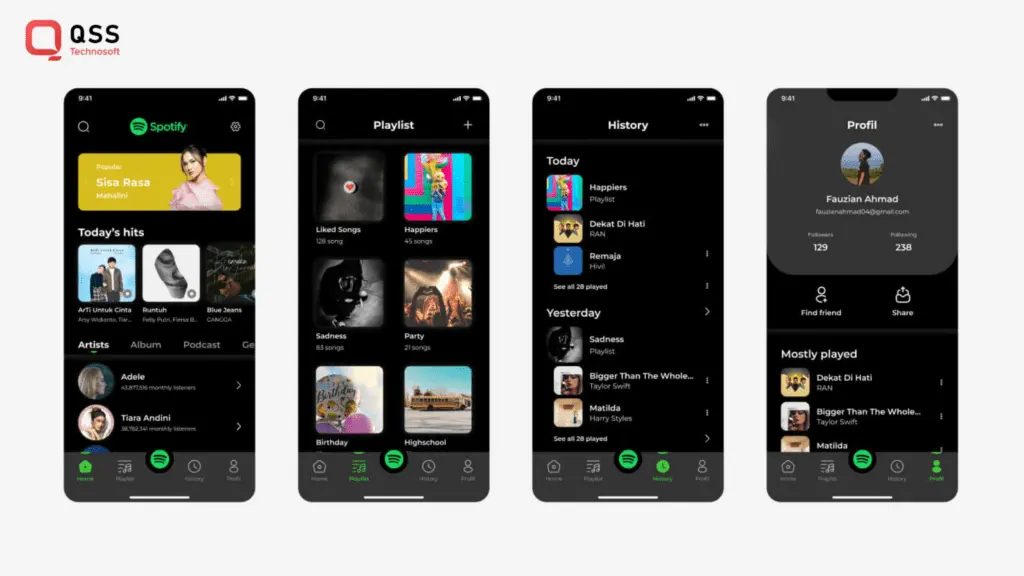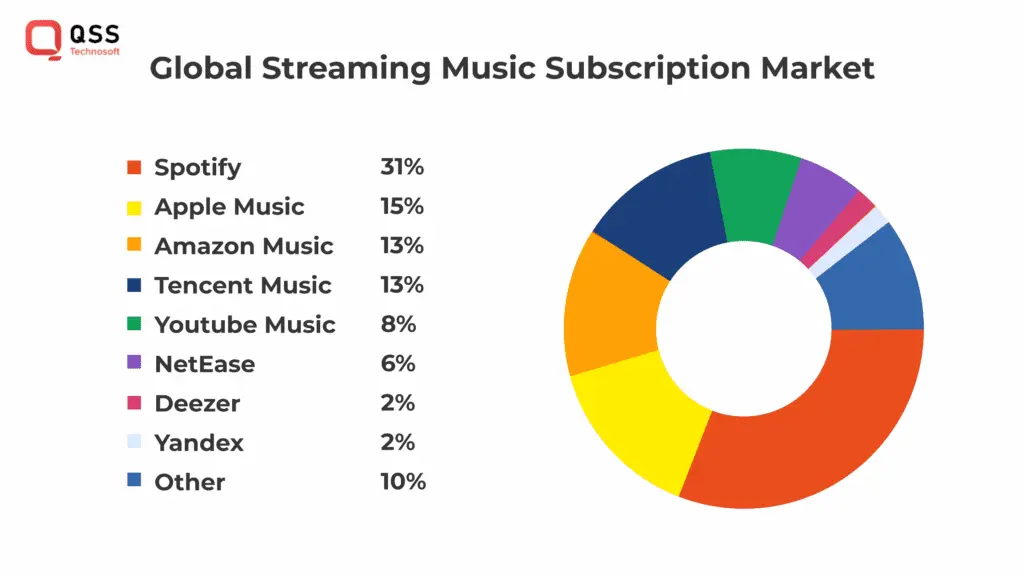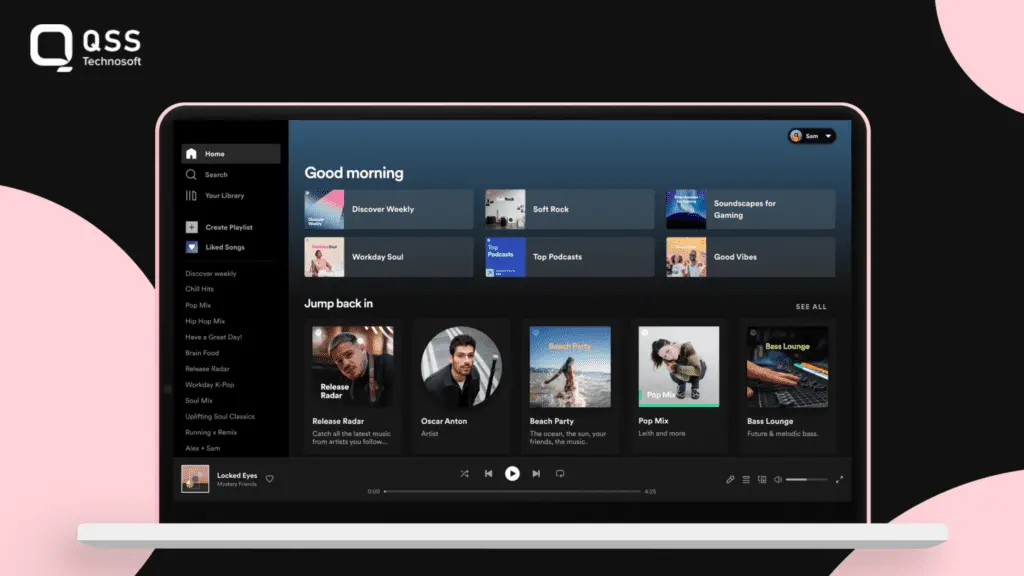In today’s digital economy, establishing a platform like Spotify can be immensely profitable. By making access to music convenient, streamlined and thoroughly engaging, Spotify Clone has truly revolutionised the way of music streaming.
But to create a successful clone of Spotify, a good understanding of technical intricacies, well thought out strategies as well as an all-round industry awareness is a must.
This aid will provide a thorough overview of the stages that go into making an app like Spotify and aims to equip you with thorough market research so that you have a better understanding of the industry’s potential.
Understanding the Music Streaming Industry
Before delving into the development process, it’s essential to have a solid grasp of the music streaming industry’s dynamics. As of my last knowledge update in January 2022, the industry has been marked by continuous growth and evolution. Here are some key insights:
Market Overview
The global music streaming market has witnessed exponential growth, driven by factors such as increasing internet penetration, the rise of smartphones, and a shift towards digital consumption. Players like Spotify, Apple Music, Amazon Music, and Deezer have dominated the market, offering a vast catalogue of songs, personalised playlists, and seamless user experiences.

Key Trends
Personalization: Users now expect personalised recommendations based on their listening habits. Machine learning algorithms analyse user preferences to create custom playlists, enhancing the overall user experience.
Podcasts Integration: Podcasts have become an integral part of many music streaming platforms. Integrating podcasts into your application can attract a broader audience and enhance user engagement.
High-Quality Audio: With the growing demand for superior audio quality, incorporating features like high-definition audio streaming can set your platform apart.
Social Integration: Social sharing features and collaborative playlists can enhance user interaction and provide a sense of community within the application.
Licensing and Copyright: Understanding the complexities of music licensing and copyright laws is crucial to avoid legal issues. Establishing partnerships with record labels and artists is a key aspect of building a music streaming platform.
Understanding the Basics : Spotify Clone App Development
Before diving into the development process, it’s crucial to understand the basic components that make up a music streaming application. Here are the key features you need to consider:
User Authentication:
- Implement a secure user authentication system to ensure user privacy and data protection.
- Utilise OAuth or other authentication protocols to allow users to log in through their existing social media accounts.
Music Library:
- Curate a vast music library that includes a diverse range of genres, artists, and albums.
- Establish partnerships with record labels or use music streaming APIs to access a wide variety of tracks.
Search and Discovery:
- Develop a robust search functionality, allowing users to find their favourite songs, artists, and albums quickly.
- Implement recommendation algorithms to suggest new music based on user preferences.
User Profiles:
- Create user profiles where users can customise their preferences, create playlists, and view their listening history.
- Incorporate features like followers, following, and public playlists to enhance social interaction within the application.
Audio Streaming:
- Integrate a high-quality audio streaming service to ensure a seamless listening experience.
- Support various audio formats and provide options for users to adjust streaming quality based on their network conditions.
Offline Mode:
- Include an offline mode that allows users to download their favourite songs for offline listening.
- Implement secure encryption to protect downloaded content and prevent unauthorised access.

Steps to Develop a Spotify Clone App
Now, let’s dive into the step-by-step process of developing a Spotify clone application:
1.Market Research and Planning
Industry Analysis
Before embarking on the development journey, conduct a thorough market analysis to identify gaps, target demographics, and potential competitors. Analyse the strengths and weaknesses of existing platforms to find opportunities for differentiation. Define Your Unique Selling Proposition (USP)
Consider what will set your Spotify clone apart. Whether it’s a unique feature, exclusive content, or a superior user interface, having a clear USP will help attract and retain users.
2.Choose the Tech Stack
Selecting the right technology stack is crucial for the success of your application. Consider factors such as scalability, security, and development speed. A typical tech stack for a music streaming app may include:
- Frontend: React or Vue.js
- Backend: Node.js or Django
- Database: MongoDB or MySQL
- Cloud Storage: AWS S3 or Google Cloud Storage
- Streaming Protocol: HTTP Live Streaming (HLS) or Dynamic Adaptive Streaming over HTTP (DASH)
3.Licensing and Copyright
Navigating the complex landscape of music licensing and copyright is essential to avoid legal issues. Consult legal experts to ensure compliance with intellectual property laws and secure the necessary licences from record labels and artists.
4.User Authentication and Profiles
Implement a secure user authentication system to protect user data. Allow users to create profiles, customise preferences, and sync their data across devices. Social media integration can streamline the sign-up process and enhance user engagement.
5.Content Management
Build a robust content management system to organise and categorise the extensive music library. Implement features such as song search, filters, and curated playlists to help users discover new music.
Also Read Our Page : Hire mobile app developers in usa
6.Music Streaming Infrastructure
Set up a reliable and scalable music streaming infrastructure. Implement features like real-time streaming, offline playback, and seamless transitions between songs. Focus on optimising audio quality and minimising latency.
7.Recommendation Engine
Integrate a powerful recommendation engine using machine learning algorithms. Analyse user behaviour, preferences, and listening history to provide personalised playlists and song suggestions.
8.Social Features
Enhance user engagement by incorporating social features. Allow users to follow friends, share playlists, and collaborate on playlists. Social integration can turn the music streaming experience into a communal activity.
9.Monetization Strategies
Consider various monetization models such as subscription plans, ad-supported free tiers, and partnerships with brands. Implement a secure payment gateway for subscription-based services.
10.Testing
Thoroughly test the application for functionality, security, and performance. Conduct beta testing with a selected group of users to gather feedback and identify potential issues.
11.Launch and Marketing
Plan a strategic launch, considering factors like geographic targeting, promotional campaigns, and partnerships. Leverage digital marketing channels to create awareness and attract the initial user base.
12.Continuous Improvement
Gather user feedback and analyse application performance post-launch. Implement regular updates, fix bugs, and introduce new features to keep the platform dynamic and competitive.

Challenges and Considerations of Developing a Spotify Clone App
1.Licensing and Royalties
Navigating the complexities of music licensing and ensuring fair compensation to artists and record labels is a significant challenge. Establish transparent agreements and work closely with legal experts to address licensing issues.
2.Competition
The music streaming industry is highly competitive, with established players dominating the market. To stand out, focus on innovation, user experience, and strategic partnerships.
3.Technical Challenges
Building a robust and scalable music streaming platform involves overcoming technical challenges such as optimising audio streaming, minimising latency, and ensuring a seamless user experience across devices.
4.User Acquisition and Retention
Attracting users in a market dominated by well-known platforms can be challenging. Implement effective marketing strategies and prioritise user retention through personalised experiences and continuous improvements.
5.Monetization Strategy
Choosing the right monetization strategy requires careful consideration. Balancing user experience with revenue generation is crucial to the long-term success of the platform.
Also Read Our Page : Blockchain developers for hire
Conclusion
Developing a Spotify clone application is a complex but rewarding endeavour. By understanding the dynamics of the music streaming industry, carefully planning each step, and addressing challenges head-on, you can create a platform that not only competes with established players but also offers a unique and compelling user experience. Stay attuned to industry trends, embrace innovation, and prioritise user satisfaction to build a successful music streaming platform in this dynamic and ever-evolving market. 
What distinguishes QSS Technosoft Inc as the optimal option for crafting a Spotify Clone application?
At QSS Technosoft Inc, we believe that the key to achieving success in the development of a Spotify clone application comes from our team’s talent and expertise. Our developers possess impressive skill sets and invaluable experience regarding app development, ensuring our Spotify clone application has the latest features and functionalities.
To maximise user experience, our designers and engineers collaborate diligently to construct convenient, intuitive, and aesthetically pleasing user interfaces. Our investment in the look and feel of our Spotify clone application endears potential and actual users alike to engage with and comprehend the application effortlessly.
Moreover, our apps strive to keep up with ever changing trends and technologies in the App development industry. Our dedicated team members stay informed on the innovations and best practices in app development, equipping QSS Technosoft Inc with the Knowledge and capability to construct app solutions tailored to the everchanging tech times.
Frequently Asked Questions (FAQs)
1.What technologies should I use to develop a Spotify clone application?
To build a Spotify clone, you can use a combination of technologies. For the frontend, consider using React or Angular. Node.js or Django are excellent choices for the backend, while MongoDB or PostgreSQL can serve as the database. For audio streaming, you might integrate services like Amazon S3 or Google Cloud Storage. Ensure secure user authentication with OAuth and implement HTTPS for data encryption.
2.Can I use Spotify’s music catalogue for my application?
No, using Spotify’s music catalogue without proper licensing is a violation of copyright laws. You should either create your music library by securing licences from record labels or use third-party APIs that provide legal access to music content.
3.How can I ensure the security of user data in my application?
Implement secure user authentication using OAuth or a similar protocol. Use HTTPS to encrypt data during transmission and ensure that sensitive information, such as passwords, is securely stored in the database. Regularly update security protocols and conduct thorough security testing.
4.What features should I prioritise for a seamless user experience?
Prioritise features such as a user-friendly interface, robust search functionality, personalised recommendations, and an efficient audio streaming service. Social features like user profiles, followers, and collaborative playlists can enhance the overall user experience.
5.How can I implement recommendation algorithms for music suggestions?
Implementing recommendation algorithms involves analysing user behaviour and preferences. Machine learning models can be used to predict user preferences based on historical data. Consider using collaborative filtering, content-based filtering, or hybrid models to enhance the accuracy of music recommendations.
6.Is it legal to create a Spotify clone application?
While creating a Spotify-inspired application is legal, it’s crucial to avoid copyright infringement. Ensure that you have the necessary licenses to use music content or use third-party APIs with legal access to music libraries. Additionally, respect user privacy and comply with data protection regulations.
7.How can I monetize my Spotify clone application?
There are several monetization strategies for a music streaming app. You can offer a subscription-based model with premium features, provide ad-supported free versions, or implement a combination of both. Additionally, partnerships, affiliate marketing, and in-app purchases for merchandise or concert tickets can contribute to revenue.
8.What challenges should I anticipate during the development process?
Common challenges include securing licensing for music content, optimizing audio streaming for various network conditions, and ensuring the scalability of your infrastructure. Additionally, staying updated on changes in the music streaming industry and adapting your application accordingly is essential.
We are proud to mention that our work has been recognized by leading B2B reviews and research platforms like GoodFirms, Clutch, MirrorView, and many more.

Spotify Clone: A Step-by-Step Guide to Developing Your Music Streaming App